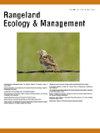山艾草-草原植物群落地理立地和生态状态的植物产量预测
IF 2.4
3区 环境科学与生态学
Q2 ECOLOGY
引用次数: 0
摘要
气候是所有牧场生态系统中植物生产的主要驱动力。牧场植物产量的月度或季节性预测可以提供有关牲畜放养率、恢复规划、野火燃料负荷和野生动物管理的有价值的管理信息。在山艾草草原生态区,植物产量不仅受气候的影响,还受地理位置、生态状态或优势植物群落的影响。在这项研究中,我们使用回顾性季节性气候预测和植物生产模型来确定月度或季节性预测(最多7个月的提前期)在地理地点和生态状态下的效用。这项研究是在俄勒冈州东南部5万平方公里的45个完整的晚期山艾草草原上进行的,历时10年。研究地点分为五个地理位置和五个生态状态。本研究的目的是:(1)模拟植物功能群对实际和预测气候的时空响应;(2)确定工厂生产预测技能,交货时间可达7个月;(3)区分不同地理位置和不同生态状态的植物生产模式和预测技能。我们发现,植物生产模型和预测能够识别关键功能群对降水和温度输入的响应。我们还确定,气候和植物产量预测可以用来为所有站点、州和植物功能组提供长达7个月的交货时间的重要月度植物产量预测。我们还发现,基于生态状态的植物总产量预测明显优于基于地理位置的预测。生态状态预测可以使管理投入与固有的场地条件相匹配,从而导致更好的牧场管理决策。本文章由计算机程序翻译,如有差异,请以英文原文为准。
Plant Production Forecasts Across Geographical Sites and Ecological States in Sagebrush-Steppe Plant Communities
Climate is the principal driver of plant production across all rangeland ecosystems. Monthly or seasonal forecasts of rangeland plant production could provide valuable management information pertaining to livestock stocking rates, restoration planning, wildfire fuel loads, and wildlife management. In the sagebrush steppe ecoregion, plant production is dependent upon climate but also varies by geographic location and the ecological state or dominant plant community. In this study, we used retrospective seasonal climate forecasts and plant production models to determine the utility of monthly or seasonal forecasting (with up to 7-month lead times) across both geographical sites and ecological states. This study was conducted in 45 intact late-seral sagebrush steppe sites over a 10-year period across a 50,000 km2 area in southeastern Oregon. Research sites were sorted into five geographical sites and into five ecological states. The objectives of this study were to (1) model plant functional group responses to actual and forecasted climate across time and space; (2) determine plant production forecast skill for lead times of up to 7 months; and (3) differentiate plant production model and forecast skill among both geographical sites and ecological states. We found that plant production models and forecasts were able to identify key functional group responses to precipitation and temperature inputs. We also determined that climate and plant production forecasts could be used to produce significant monthly plant production forecasts for lead-times of up to 7-months for all site, state, and plant functional groupings. We also determined that forecasts of total plant production by ecological state were significantly better than forecasts based on geographical sites. Forecasting by ecological state could lead to better rangeland management decisions as it matches management inputs with inherent site conditions.
求助全文
通过发布文献求助,成功后即可免费获取论文全文。
去求助
来源期刊

Rangeland Ecology & Management
农林科学-环境科学
CiteScore
4.60
自引率
13.00%
发文量
87
审稿时长
12-24 weeks
期刊介绍:
Rangeland Ecology & Management publishes all topics-including ecology, management, socioeconomic and policy-pertaining to global rangelands. The journal''s mission is to inform academics, ecosystem managers and policy makers of science-based information to promote sound rangeland stewardship. Author submissions are published in five manuscript categories: original research papers, high-profile forum topics, concept syntheses, as well as research and technical notes.
Rangelands represent approximately 50% of the Earth''s land area and provision multiple ecosystem services for large human populations. This expansive and diverse land area functions as coupled human-ecological systems. Knowledge of both social and biophysical system components and their interactions represent the foundation for informed rangeland stewardship. Rangeland Ecology & Management uniquely integrates information from multiple system components to address current and pending challenges confronting global rangelands.
 求助内容:
求助内容: 应助结果提醒方式:
应助结果提醒方式:


